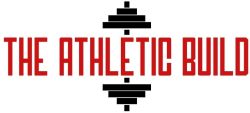Movement is a part of our lives we take for granted. Without fail, you swing your arm over to the alarm clock to hit snooze every morning. You bend down to tie your shoes each day with ease. But do you ever stop and think about how important movement is?
When it comes to staying healthy and active, movement is essential, and how quickly you can move plays a significant role in your overall fitness. With speed and agility training, you can tackle your athletic goals quicker than you ever thought possible!
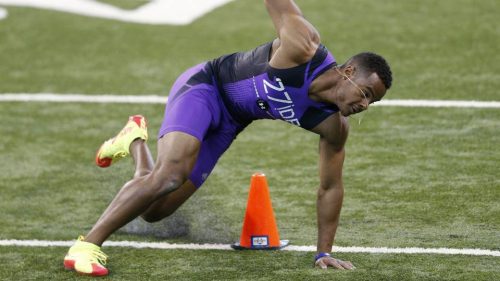
What is Agility?
Simply put, agility is the ability to move quickly. It requires your body’s muscle strength, balance, and reflexes to work together in harmony, helping to increase endurance. Whether you need to move forward or back, left or right, or at an angle, the quicker your body can move, the more agility you have.
Why is Speed and Agility Training Important?
When it comes to sports and working out, speed and agility are key to improving. With more agility, you can harness more power to enhance your performance and achieve better results. This is especially important if you’re someone who enjoys sports competitions since agility can give you the upper hand against your opponent.
In addition to sports competitions, high agility levels can also provide numerous benefits such as:
- Reduced risk of injury
- Enhanced coordination
- Increased heart rate and blood flow throughout the body
- Elevated connection between mind and body for improved levels of focus
- Prevention of burnouts and weight plateaus
- Shortened muscle recovery times
How to Increase Speed and Agility
So, now that you know all the great benefits of speed and agility training, why not add it to your weekly routine? Gather a few pieces of training equipment and utilize our workouts to increase your agility.
Speed and Agility Training Equipment
Before we go over the best exercises to improve agility lets go over the equipment. To enhance your agility training, try using a few or a combination of all of these pieces of equipment. By switching up the equipment, you can target different areas of your body.
Sleds
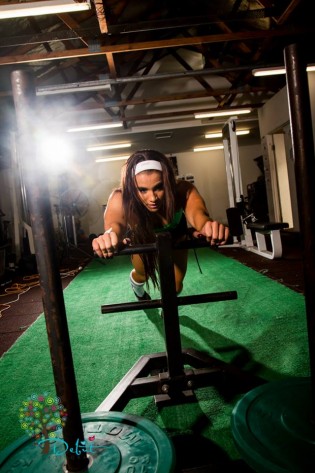
Because they’re so versatile and easy to use, training sleds are very common within gyms that offer speed and agility training programs. Sleds allow you to adjust the amount of weight you push, pull, or drag to increase speed and strength. When using a sled, your body mimics a running stance. However, instead of running upright, you have the option of sprinting forward, backward, or sideways. You also engage more muscles, ensuring a full-body workout every time.
Resistance Bands
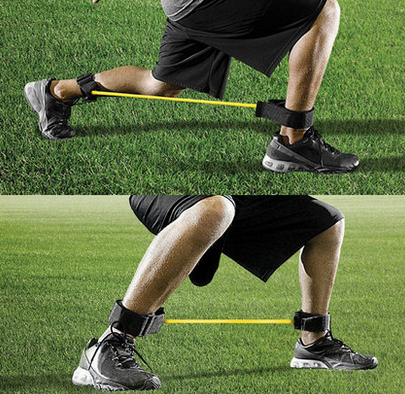
Incorporating resistance bands into your routine allows you to strengthen specific muscles and increase your endurance. These bands come in a variety of resistance levels so you always have the ability to level up. You can also place them on different parts of your legs to improve various areas such as your ankles, calves, and thighs.
Ladders
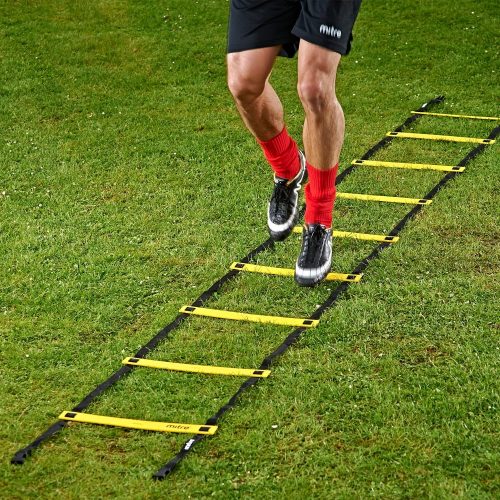
Ladders look like traditional, upright ladders, but are generally made of rope and lie flat on the ground. You simply need to move your feet quickly through each box to make it from one end to the other. Trainers often incorporate these into workouts because they’re so simple to use and they fold up for easy travel.
Cones
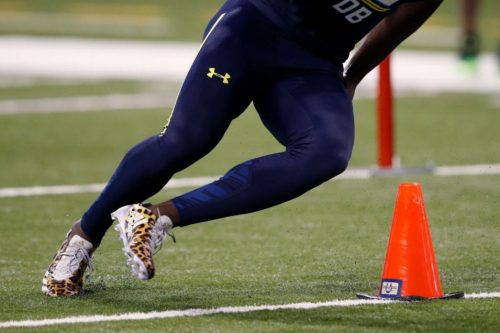
Cones are another versatile piece of equipment when it comes to agility. They can be placed in any order or pattern to create a course. To enhance strength and endurance, athletes will practice running through the course over and over again. As cones are placed closer together, the harder your brain needs to work to ensure your feet make the correct movements as quickly as possible.
Related: 5 Benefits of Doing Cone Drills
Step Hurdles
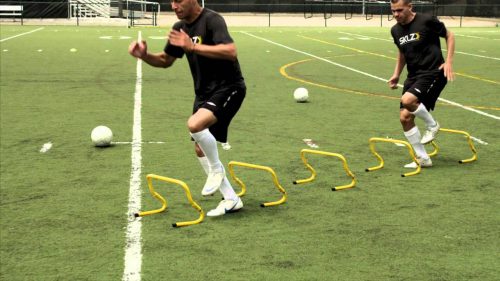
Hurdles come in a range of heights and widths and are great for running agility drills. Depending on the height of your hurdles, you can run over them, hop over them, and sidestep over them. After you find your groove over time, you can increase your step hurdle speed and boost your agility level.
Workouts to Improve Agility
Here’s the fun part! Using the pieces of equipment above, give some of these 15-minute agility workouts a try. They’re perfect for spicing up traditional lifting and cardio sessions.
Combination Drill #1
- Cones: Place cones in zig-zag formation; run through course 4 times total
- 30-second break
- Cones: Place cones in zig-zag formation; run through course 3 times total
- 20-second break
- Cones: Place cones in zig-zag formation; run through course 2 times total
- 10-second break
- Ladder: Leap through box sections 2 at a time; up and back 4 times total
- 30-second break
- Ladder: Leap through box sections 2 at a time; up and back 3 times total
- 20-second break
- Ladder: Leap through box sections 2 at a time; up and back 2 times total
- 10-second break
- Resistance Bands: Place band around thighs; facing a wall, lean against it at a 45-degree angle; hike knees up as high and as quickly as possible for 30 seconds
- 30-second break
- Resistance Bands: Place band around thighs; facing a wall, lean against it at a 45-degree angle; hike knees up as high and as quickly as possible for 20 seconds
- 20-second break
- Resistance Bands: Place band around thighs; facing a wall, lean against it at a 45-degree angle; hike knees up as high and as quickly as possible for 10 seconds
- 10-second break
Combination Drill #2
- Sled: Push forward and back, stopping at 20 feet, 40 feet, and 60 feet; 3 reps total
- 30-second break
- Sled: Push forward and back, stopping at 20 feet, 40 feet, and 60 feet; 2 reps total
- 20-second break
- Sled: Push forward and back, stopping at 20 feet, 40 feet, and 60 feet; 1 rep total
- 10-second break
- Resistance Bands: Place bands around thighs; jump lunge as many times as possible for 30 seconds
- 30-second break
- Resistance Bands: Place bands around thighs; jump lunge as many times as possible for 20 seconds
- 20-second break
- Resistance Bands: Place bands around thighs; jump lunge as many times as possible for 10 seconds
- 10-second break
- Step Hurdles: Line 10 small hurdles up; hop sideways up and back 4 times
- 30-second break
- Step Hurdles: Line 10 small hurdles up; hop sideways up and back 3 times
- 20-second break
- Step Hurdles: Line small hurdles up; hop sideways up and back 2 times
- 10-second break
Combination Drill #3
- Ladder: Place both feet in first box; jump and put both feet outside of the second box; continue alternating up and back 4 times total
- 30-second break
- Ladder: Place both feet in first box; jump and put both feet outside of the second box; continue alternating up and back 3 times total
- 20-second break
- Ladder: Place both feet in first box; jump and put both feet outside of the second box; continue alternating up and back 2 times total
- 10-second break
- Cones: Place cones 20 feet apart in a W formation; run course 4 times total
- 30-second break
- Cones: Place cones 20 feet apart in a W formation; run course 3 times total
- 20-second break
- Cones: Place cones 20 feet apart in a W formation; run course 2 times total
- 10-second break
- Resistance Bands: Place band around thighs; get into plank formation; do mountain climbers as quickly as possible for 30 seconds
- 30-second break
- Resistance Bands: Place band around thighs; get into plank formation; do mountain climbers as quickly as possible for 20 seconds
- 20-second break
- Resistance Bands: Place band around thighs; get into plank formation; do mountain climbers as quickly as possible for 10 seconds
- 10-second break
Testing & Measuring Agility for Results
If you’re planning on getting started with speed and agility training, be sure to test your agility from the start! By testing your current speed and agility levels, you’ll be able to see just how much you improve over time.
There is a range of different agility tests you can conduct to help you measure what level you’re at now. It’s best to complete as many agility tests as you can before you begin training so you have a lot of test results you can compare to later on. Agility tests can include measuring anything from how fast you can run a cone circuit to how quickly you can sprint 20 yards.
Want to learn first-hand how to incorporate agility training into your routine? Contact iTrainStudio today to talk with one of our professional trainers!

Wayne Mutata is a Certified USA Weightlifting Coach, Nike SPARQ Combine Trainer, and recognized supplement specialist with over a decade of professional experience. He holds a Master’s degree in Physiology and Anatomy, along with double minors in Dietary Nutrition and Exercise Science from the National Personal Training Institute of Philadelphia.
Wayne is a sought-after Strength and Conditioning expert, working with professional athletes including MMA fighters and elite Figure/Bikini competitors. His training methods are grounded in science and tailored for peak performance. Beyond coaching, Wayne has built a public profile as a fitness model and on-camera fitness personality, appearing on the cover of Fitness101 magazine and earning a nomination in the Men’s Health Ultimate Guy competition.
As the founder of Itrainwithwayne, he delivers custom workout programs, supplement protocols, and online training to clients across the United States and internationally. The Itrainwithwayne brand operates two training studios, the headquarters in Lancaster, PA, and a second location in Philadelphia, PA.
